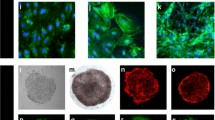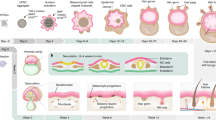Abstract
The marine mammalian Indo-Pacific humpback dolphin, once widely lived in waters of the Indian to western Pacific oceans, has become an endangered species. The individual number of this dolphin has significantly declined in recent decades, which raises the concern of extinction. Direct concentration on laboratorial conservation of the genetic and cell resources should be paid to this marine species. Here, we report the successful derivation of cell lines form the skin of Indo-Pacific humpback dolphin. The cell cultures displayed the characteristics of fibroblast in morphology and grew rapidly at early passages, but showed obvious growth arrest at higher passages. The karyotype of the cells consisted of 42 autosomes and sex chromosomes X and Y. The immortalized cell lines obtained by forced expression of the SV40 large T-antigen were capable of proliferation at high rate in long-term culture. Immortalization and long-term culture did not cause cytogenetically observable abnormality in the karyotype. The cell type of the primary cultures and immortalized cell lines were further characterized as fibroblasts by the specific expression of vimentin. Gene transfer experiments showed that exogenetic genes could be efficiently delivered into the cells by both plasmid transfection and lentivirus infection. The cells derived from the skin of the Indo-Pacific humpback dolphin may serve as a useful in vitro system for studies on the effects of environmental pollutants and pathogens in habitats on the dolphin animals. More importantly, because of their high proliferation rate and susceptibility to lentivirus, these cells are potential ideal materials for generation of induced pluripotent stem cells.






Similar content being viewed by others
References
Bangs, C.; Donlon A. Metaphase chromosome preparation from cultured peripheral blood cells. Curr. Protoc. Hum. Genet. Chapter 4, Unit 41; 2005.
Ben-Nun I.; Montague S. et al. Induced pluripotent stem cells from highly endangered species. Nat. Methods 8: 829–831; 2011.
Carvan M.; Flood L. et al. Effects of benzo(a)pyrene and tetrachlorodibenzo (p) dioxin on fetal dolphin kidney cells: inhibition of proliferation and initiation of DNA damage. Chemosphere 30: 187–198; 1995.
Carvan M.; Santostefano M. et al. Characterization of a bottlenose dolphin kidney (Tursiops truncatus) epithelial cell line. Mar. Mamm. Sci. 10: 52–69; 1994.
Dalton R. Last hope for river dolphins. Nature 440: 1096–1097; 2006.
Frere C.; Seddon J. et al. Multiple lines of evidence for an Australasian geographic boundary in the Indo-Pacific humpback dolphin (Sousa chinensis): population or species divergence? Conserv. Genet. 12: 1633–1638; 2011.
Hahn W.; Dessain S. et al. Enumeration of the simian virus 40 early region elements necessary for human cell transformation. Mol. Cell. Biol. 22: 2111–2123; 2002.
Heinzelmann L.; Chagastelles P. et al. The karyotype of Franciscana dolphin (Pontoporia blainvillei). J. Hered. 100: 119–122; 2009.
Huang S.; Karczmarskin L. et al. Demography and population trends of the largest population of Indo-Pacific humpback dolphins. Biol. Conserv. 147: 234–242; 2012.
Jefferson T. Population biology of the Indo-Pacific hump-backed dolphin in Hong Kong waters. Wildl. Monogr. 144: 1–65; 2000.
Karczmarski L.; Cockroft V. et al. Habitat use and preferences of Indo-Pacific humpback dolphins Sousa chinensis in Algoa Bay, South Africa. Mar. Mamm. Sci. 16: 65–79; 2000.
Kueper T.; Grune T. et al. Modification of vimentin: a general mechanism of nonenzymatic glycation in human skin. Ann. N. Y. Acad. Sci. 1126: 328–332; 2008.
Li Chen T.; Wise S. et al. Cytotoxicity and genotoxicity of hexavalent chromium in human and North Atlantic right whale (Eubalaena glacialis) lung cells. Comp. Biochem. Physiol. C Toxicol. Pharmacol. 150: 487–494; 2009.
Li S.; Wang D. et al. Evoked-potential audiogram of an Indo-Pacific humpback dolphin (Sousa chinensis). J. Exp. Biol. 215: 3055–3063; 2012.
Lin W.; Zhou R. et al. Evolution of Sousa chinensis: a scenario based on mitochondrial DNA study. Mol. Phylogenet. Evol. 57: 907–911; 2010.
Ono M.; Murakami T. et al. Quantitative comparison of anti-fading mounting media for confocal laser scanning microscopy. J. Histochem. Cytochem. 49: 305–312; 2001.
Turvey S.; Pitman R. et al. First human-caused extinction of a cetacean species? Biol. Lett. 3: 537–540; 2007.
Wang J.; Su W. et al. Establishment and characterization of fibroblast cell lines from the skin of the Yangtze finless porpoise. In Vitro Cell Dev. Biol. Anim. 47: 618–630; 2011.
Yang H.; Shi L. et al. Generation of genetically modified mice by oocyte injection of androgenetic haploid embryonic stem cells. Cell 149: 605–617; 2012.
Yi M.; Hong N. et al. Generation of medaka fish haploid embryonic stem cells. Science 326: 430–433; 2009.
Yi M.; Hong N. et al. Derivation and characterization of haploid embryonic stem cell cultures in medaka fish. Nat. Protoc. 5(8): 1418–1430; 2010.
Yu J.; Kindy M. et al. Establishment of epidermal cell lines derived from the skin of the Atlantic bottlenose dolphin (Tursiops truncatus). Anat. Rec. A Discov. Mol. Cell Evol. Biol. 287: 1246–1255; 2005.
Acknowledgments
The authors would like to thank the Ocean Park Conservation Foundation HK for assist in sample collection. The work was supported by the Sun Yat-Sen University (grant no. 42000-3281303), the National Natural Science Foundation of China (grant nos. 31271576, 41276147), the Ph.D. Programs Foundation of Ministry of Education of China (grant no. 20120171110033), and the Sousa chinensis Conservation Action Project from the Administrator of Ocean and Fisheries of Guangdong Province, China.
Author information
Authors and Affiliations
Corresponding authors
Additional information
Editor: T. Okamoto
Rights and permissions
About this article
Cite this article
Jin, W., Jia, K., Yang, L. et al. Derivation and characterization of cell cultures from the skin of the Indo-Pacific humpback dolphin Sousa chinensis . In Vitro Cell.Dev.Biol.-Animal 49, 449–457 (2013). https://doi.org/10.1007/s11626-013-9611-7
Received:
Accepted:
Published:
Issue Date:
DOI: https://doi.org/10.1007/s11626-013-9611-7




